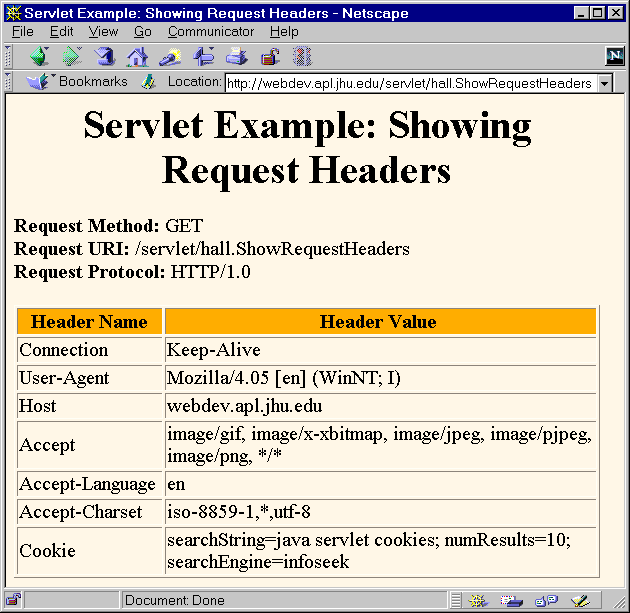

| Reading HTTP Request Headers |
|---|
GET or POST).
If it wants to, it can also send a number of headers, all of which are optional except for
Content-Length, which is required only for POST requests.
Here are the most common headers:
Accept The MIME types the browser prefers.
Accept-Charset The character set the browser expects.
Accept-Encoding The types of data encodings (such as gzip)
the browser knows how to decode. Servlets can explicitly check for
gzip support and return gzipped HTML pages to browsers that support them,
setting the Content-Encoding response header to indicate that they
are gzipped. In many cases, this can reduce page download times by a factor of
five or ten.
Accept-Language The language the browser is expecting,
in case the server has versions in more than one language.
Authorization Authorization info, usually in response
to a WWW-Authenticate header from the server.
Connection Use persistent connection? If a servlet gets
a Keep-Alive value here, or gets a request line indicating HTTP 1.1
(where persistent connections are the default), it may be able to take
advantage of persistent connections, saving significant time for Web pages that
include several small pieces (images or applet classes). To do
this, it needs to send a Content-Length header in the response,
which is most easily accomplished by writing into a
ByteArrayOutputStream, then looking up the size just before
writing it out.
Content-Length (for POST messages, how much data
is attached)
Cookie (one of the most important headers; see separate
section in this tutorial on handling cookies)
From (email address of requester; only used by Web spiders
and other custom clients, not by browsers)
Host (host and port as listed in the original URL)
If-Modified-Since (only return documents newer than this,
otherwise send a 304 "Not Modified" response)
Pragma (the no-cache value indicates that the server should
return a fresh document, even if it is a proxy with a local copy)
Referer (the URL of the page containing the link the user
followed to get to current page)
User-Agent (type of browser, useful if servlet is returning
browser-specific content)
UA-Pixels, UA-Color, UA-OS, UA-CPU
(nonstandard headers sent by some Internet Explorer versions, indicating screen size,
color depth, operating system, and cpu type used by the browser's
system)
getHeader method of the HttpServletRequest,
which returns a String if the header was supplied on this
request, null otherwise. However, there are a
couple of headers that are so commonly used that they
have special access methods. The getCookies method
returns the contents of the Cookie header, parsed and
stored in an array of Cookie objects. See the separate section
of this tutorial on cookies. The getAuthType and getRemoteUser
methods break the Authorization header into its component
pieces. The getDateHeader and getIntHeader methods read
the specified header and then convert them to Date
and int values, respectively.
Rather than looking up one particular header, you
can use the getHeaderNames to get an Enumeration of
all header names received on this particular request.
Finally, in addition to looking up the request headers, you can get
information on the main request line itself. The
getMethod method returns the main request method (normally
GET or POST, but things like
HEAD, PUT, and DELETE are
possible). The getRequestURI method returns the URI (the
part of the URL that came after the host and port, but before
the form data). The getRequestProtocol returns the third
part of the request line, which is generally "HTTP/1.0"
or "HTTP/1.1".
package hall;
import java.io.*;
import javax.servlet.*;
import javax.servlet.http.*;
import java.util.*;
public class ShowRequestHeaders extends HttpServlet {
public void doGet(HttpServletRequest request,
HttpServletResponse response)
throws ServletException, IOException {
response.setContentType("text/html");
PrintWriter out = response.getWriter();
String title = "Servlet Example: Showing Request Headers";
out.println(ServletUtilities.headWithTitle(title) +
"<BODY BGCOLOR=\"#FDF5E6\">\n" +
"<H1 ALIGN=CENTER>" + title + "</H1>\n" +
"<B>Request Method: </B>" +
request.getMethod() + "<BR>\n" +
"<B>Request URI: </B>" +
request.getRequestURI() + "<BR>\n" +
"<B>Request Protocol: </B>" +
request.getProtocol() + "<BR><BR>\n" +
"<TABLE BORDER=1 ALIGN=CENTER>\n" +
"<TR BGCOLOR=\"#FFAD00\">\n" +
"<TH>Header Name<TH>Header Value");
Enumeration headerNames = request.getHeaderNames();
while(headerNames.hasMoreElements()) {
String headerName = (String)headerNames.nextElement();
out.println("<TR><TD>" + headerName);
out.println(" <TD>" + request.getHeader(headerName));
}
out.println("</TABLE>\n</BODY></HTML>");
}
public void doPost(HttpServletRequest request,
HttpServletResponse response)
throws ServletException, IOException {
doGet(request, response);
}
}
Cookie header when you get to the
tutorial section
on cookies.



|
|---|
| Order now |
This tutorial was a very early outline of the material that eventually became Core Servlets and JavaServer Pages (Sun Microsystems Press and Prentice Hall, May 2000). See http://www.coreservlets.com/ for the topics covered, table of contents, index, reader reviews, and complete source code archive.